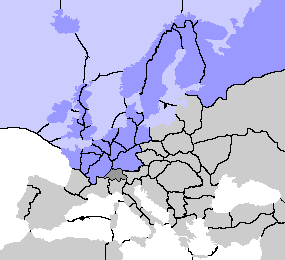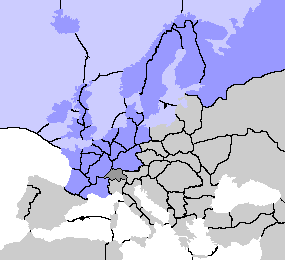During the past few years, a number of analyses of Western stalemate
positions were published. See, for example, the articles by John
Beshara and Robert Lipton, and my own "Western Stalemate Positions"
in Graustark #313. None of these, however, extended a certain
fundamental progression: Positions not requiring control of the
Mid-Atlantic.

Remove A Pic and A Bel. Add A Bur and with support from Paris and Ruhr, this new position requires only 11 units for 12 centers. From here, trade-in A Den for A Ber and F Bal. By supporting Berlin with A Kie and F Bal, there are now 12 units and 13 centers. Notice in the last two positions StP is expendable; the stalemate is effective with A Swe S Nwy.
(A slight reduction of this position appeared in John Beshara's
"Fundamental Stalemate Positions, IV"
in Atlantis #73).

Extensions proceed in two directions:
First, heading towards Russia, add armies in Prussia and Livonia, remove A Nwy and A Ruh. A Ber & A Kie S Mun, F Bal S Pru, A StP S A Lvn, making the position solid.
Next, exchange F Bal for A Sil, to be supported from Berlin and
Prussia. A new A Mos supported from A Lvn and A StP adds another
center. Alternatively, A War is controlled by support from A Pru
& A Lvn. To hold both Mos and War, move A Lvn-Mos. Then A
Pru S War, A StP S Mos, owns 16 centers with 14 units.
 Finally, remove A Pru and A StP in favor of A Ukr to arrive at:
Finally, remove A Pru and A StP in favor of A Ukr to arrive at:
This position of 16 centers with 13 units allows certain reductions without sacrificing the stalemate:
Remove A Par, add A Pic, A Bel and A Ruh. To retain this stalemate,
F Eng and A Pic S Bre, A Bel and A Ruh S Par, needing all the
units of the 15 centers.
 By removing A Bre, A Bur, A Pic and replacing them with A Hol
and F Nth, we arrive at a position Robert Lipton previously published:
By removing A Bre, A Bur, A Pic and replacing them with A Hol
and F Nth, we arrive at a position Robert Lipton previously published:
Returning to position 2 again and heading towards Iberia instead
of Russia, we see that by moving A Par-Gas and then ordering A
Ber and A Bur S Gas, we're again solid. From here, build F Mid,
supporting with all three fleets in the coastal waters off England.
A Bre becomes superfluous.
 With another of the above variations, Marseilles is held by A
Bur and A Gas, reaching the last basic position:
With another of the above variations, Marseilles is held by A
Bur and A Gas, reaching the last basic position:
All positions described herein assume unopposed dominance of Northern
waters by the stalemating power or alliance. Combinations of progressions
proceedings in the two directions from position 2 are generally
viable and sufficiently obvious so as not to require delineation.